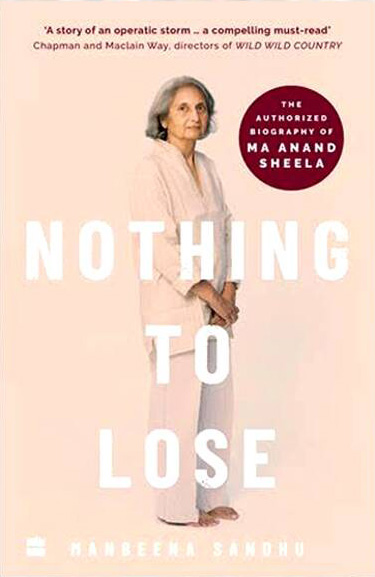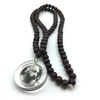‘Nothing to Lose’ – HarperCollins publishes a fairy tale with Sheela as the heroine

The authorized biography of Ma Anand Sheela
by Manbeena Sandhu
HarperCollins, India
amazon.com – amazon.de – amazon.in
It is hard to feel sympathy for a person who insists on telling lies. But that is what we are asked to do by Ma Anand Sheela, in her authorized biography, titled “Nothing to Lose,” now published by HarperCollins.
The book is designed to make a big splash in the media, especially in America. The publisher, having bought the rights to Sheela’s story, is counting on it.
So, it will soon be apparent whether the book’s reviewers, the TV chat show hosts and the public will accept Sheela’s account of what happened.
If they do, then, like Manbeena Sandhu, Sheela’s starry-eyed biographer who wrote the book, they will need to ignore a lot of evidence that points to her deceptions.
Nevertheless, Sheela may get away with it, because her version of life with Osho feeds into the mainstream’s assumptions about greedy gurus and gullible followers.
The book’s narrative, in a nutshell, is as follows:
Sheela, as a 16 year-old girl, fell madly in love with Acharya Rajneesh, as Osho was then called, and nine years later joined his ashram in Pune, quickly becoming an assistant to his secretary, Ma Yoga Laxmi.
Meanwhile, thousands of people from around the world were pouring into Pune to be with Osho. These “followers” are invariably described by Manbeena Sandhu in sarcastic terms as befuddled, dazed, sex mad, hedonistic and blindly obedient to Osho’s every command.
Osho himself is portrayed as a shrewd businessman, a charismatic speaker and an artful guru who knows how to manipulate people.
The book relates that in 1981, when Osho’s health began to fail and Laxmi could not find land for a big commune in India, Sheela succeeded in taking him to America and bought the 120 square-mile Big Muddy Ranch in Oregon.
There, Sheela presided over the construction of a town for 3,500 people, but then comes the book’s dramatic turning point – and this is where Manbeena Sandhu relies heavily on conventional attitudes to keep the reader on Sheela’s side.
According to her, the guru suddenly developed a huge appetite for expensive toys, including Rolls Royce cars and diamond watches, and Sheela felt torn between her love for him and her “motherly” care for feeding and housing the community.
Eventually the tension became too much. Sheela cracked, resigned and left. In a fit of anger, the guru then accused her of a host of crimes, for which she was arrested and wrongly imprisoned.
Then, after serving her time, Sheela was released and – true to her selfless nature – has subsequently devoted her life to looking after disabled people in a Swiss care home.
This, then, is the gospel according to Saint Sheela, as dictated to her credulous scribe, Manbeena Sandhu.
The reality, as many people know who lived through those Pune and Oregon years, is somewhat different. And the truth is not hard to find, if anyone possesses sufficient intelligence and drive to look for it.
Three of Sheela’s closest aides on the Oregon Ranch have testified in detail concerning her attempt to murder Osho’s doctor, Devaraj, and to assassinate the US Attorney for Oregon, Charles Turner, as well as numerous other crimes.
One of these aides, Ava Avalos, decided to turn informer, so her testimony, though convincing, could be dismissed as motivated by her bid to gain immunity from prosecution.
But books written by Samadhi Longo-Disse and Jane Stork (Shanti B), both of whom stayed loyal to Sheela and refused to testify against her, confirm Ava’s tale, telling the true story.
Both women went to jail for their part in these crimes. Samadhi served the longest sentence of all those who were imprisoned.
In addition to the crimes, scores of Ranch residents could have testified, if asked, to the abuse, cruelty and harassment they suffered at Sheela’s hands and at the hands of her willing lieutenants.
This doesn’t mean that Sheela needs to be condemned for what she did. Nor does it detract from the enthusiasm, exuberance, love and fulfilment that so many sannyasins felt while living and working in the Pune Ashram and Oregon Ranch.
Perhaps the biggest crime of this book is that at no time does the writer allow the possibility that Osho was, indeed, an enlightened mystic whose motivation was to offer a taste of the ultimate spiritual experience to as many people as possible.
That’s never on Manbeena Sandhu’s literary bucket list. Her ignorance about who Osho really was and what he tried to do is her book’s biggest flaw.
In conclusion, it’s unfortunate that the writer’s uncritical worship of Sheela results in an attempt to warp history, deny reality and feed into mainstream prejudices.
What a pity. It was a good opportunity for Sheela to reflect on her mistakes, admit her weaknesses and apologize to those whom she wronged. In this regard, the book falls woefully short.
Related article with short excerpt
- Exploring each crossroads – Once again the Indian media is in full swing, reporting breathlessly about two new books to be published this year, both about Sheela.
Subhuti is a writer, author of many books, including the recent, Wild Wild Guru. subhutianand.com
- Log in to post comments
- 10 views
